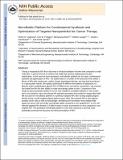| dc.contributor.author | Valencia, Pedro M. | |
| dc.contributor.author | Pridgen, Eric M. | |
| dc.contributor.author | Rhee, Minsoung | |
| dc.contributor.author | Langer, Robert | |
| dc.contributor.author | Farokhzad, Omid C. | |
| dc.contributor.author | Karnik, Rohit | |
| dc.date.accessioned | 2015-06-26T14:54:34Z | |
| dc.date.available | 2015-06-26T14:54:34Z | |
| dc.date.issued | 2013-11 | |
| dc.date.submitted | 2013-07 | |
| dc.identifier.issn | 1936-0851 | |
| dc.identifier.issn | 1936-086X | |
| dc.identifier.uri | http://hdl.handle.net/1721.1/97535 | |
| dc.description.abstract | Taking a nanoparticle (NP) from discovery to clinical translation has been slow compared to small molecules, in part by the lack of systems that enable their precise engineering and rapid optimization. In this work we have developed a microfluidic platform for the rapid, combinatorial synthesis and optimization of NPs. The system takes in a number of NP precursors from which a library of NPs with varying size, surface charge, target ligand density, and drug load is produced in a reproducible manner. We rapidly synthesized 45 different formulations of poly(lactic-co-glycolic acid)-b-poly(ethylene glycol) NPs of different size and surface composition and screened and ranked the NPs for their ability to evade macrophage uptake in vitro. Comparison of the results to pharmacokinetic studies in vivo in mice revealed a correlation between in vitro screen and in vivo behavior. Next, we selected NP synthesis parameters that resulted in longer blood half-life and used the microfluidic platform to synthesize targeted NPs with varying targeting ligand density (using a model targeting ligand against cancer cells). We screened NPs in vitro against prostate cancer cells as well as macrophages, identifying one formulation that exhibited high uptake by cancer cells yet similar macrophage uptake compared to nontargeted NPs. In vivo, the selected targeted NPs showed a 3.5-fold increase in tumor accumulation in mice compared to nontargeted NPs. The developed microfluidic platform in this work represents a tool that could potentially accelerate the discovery and clinical translation of NPs. | en_US |
| dc.description.sponsorship | Prostate Cancer Foundation (Award in Nanotherapeutics) | en_US |
| dc.description.sponsorship | National Cancer Institute (U.S.) (Center of Cancer Nanotechnology Excellence at MIT-Harvard U54-CA151884 | en_US |
| dc.description.sponsorship | National Heart, Lung, and Blood Institute (Programs of Excellence in Nanotechnology HHSN268201000045C) | en_US |
| dc.description.sponsorship | National Science Foundation (U.S.). Graduate Research Fellowship | en_US |
| dc.description.sponsorship | American Society for Engineering Education. National Defense Science and Engineering Graduate Fellowship | en_US |
| dc.description.sponsorship | National Cancer Institute (U.S.) (Center of Cancer Nanotechnology Excellence. Graduate Research Fellowship) | en_US |
| dc.language.iso | en_US | |
| dc.publisher | American Chemical Society (ACS) | en_US |
| dc.relation.isversionof | http://dx.doi.org/10.1021/nn403370e | en_US |
| dc.rights | Article is made available in accordance with the publisher's policy and may be subject to US copyright law. Please refer to the publisher's site for terms of use. | en_US |
| dc.source | PMC | en_US |
| dc.title | Microfluidic Platform for Combinatorial Synthesis and Optimization of Targeted Nanoparticles for Cancer Therapy | en_US |
| dc.type | Article | en_US |
| dc.identifier.citation | Valencia, Pedro M., Eric M. Pridgen, Minsoung Rhee, Robert Langer, Omid C. Farokhzad, and Rohit Karnik. “Microfluidic Platform for Combinatorial Synthesis and Optimization of Targeted Nanoparticles for Cancer Therapy.” ACS Nano 7, no. 12 (December 23, 2013): 10671–10680. | en_US |
| dc.contributor.department | MIT-Harvard Center for Cancer Nanotechnology Excellence | en_US |
| dc.contributor.department | Massachusetts Institute of Technology. Institute for Medical Engineering & Science | en_US |
| dc.contributor.department | Massachusetts Institute of Technology. Department of Chemical Engineering | en_US |
| dc.contributor.department | Massachusetts Institute of Technology. Department of Mechanical Engineering | en_US |
| dc.contributor.department | Koch Institute for Integrative Cancer Research at MIT | en_US |
| dc.contributor.mitauthor | Valencia, Pedro M. | en_US |
| dc.contributor.mitauthor | Pridgen, Eric M. | en_US |
| dc.contributor.mitauthor | Rhee, Minsoung | en_US |
| dc.contributor.mitauthor | Langer, Robert | en_US |
| dc.contributor.mitauthor | Farokhzad, Omid C. | en_US |
| dc.contributor.mitauthor | Karnik, Rohit | en_US |
| dc.relation.journal | ACS Nano | en_US |
| dc.eprint.version | Author's final manuscript | en_US |
| dc.type.uri | http://purl.org/eprint/type/JournalArticle | en_US |
| eprint.status | http://purl.org/eprint/status/PeerReviewed | en_US |
| dspace.orderedauthors | Valencia, Pedro M.; Pridgen, Eric M.; Rhee, Minsoung; Langer, Robert; Farokhzad, Omid C.; Karnik, Rohit | en_US |
| dc.identifier.orcid | https://orcid.org/0000-0003-0588-9286 | |
| dc.identifier.orcid | https://orcid.org/0000-0002-2640-3006 | |
| dc.identifier.orcid | https://orcid.org/0000-0003-4255-0492 | |
| dspace.mitauthor.error | true | |
| mit.license | PUBLISHER_POLICY | en_US |
| mit.metadata.status | Complete | |
